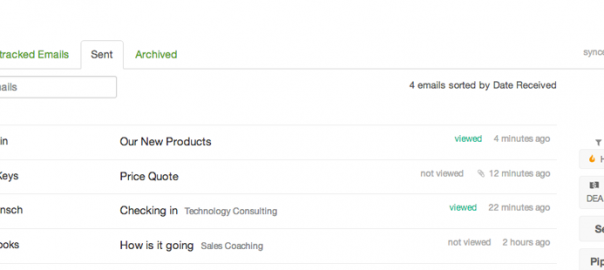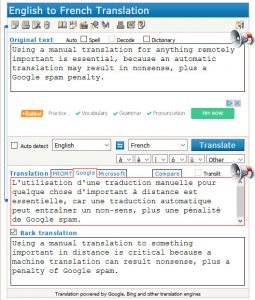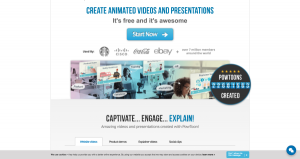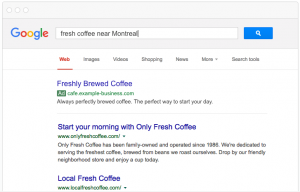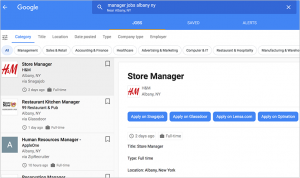We all know what it’s like to send a qualified prospect our highest converting sales pitch, only to receive total radio silence in return. We get stuck wondering why our prospect didn’t respond, what happened since the last time we spoke, and what we should say next.
In fact, losing touch with a prospect is so common that many of us have already established a protocol for sending a follow-up email after no response. But are you putting as much care and consideration into your follow-up emails as you should?
A personalized follow-up email can improve customer relationships and help you reach your sales goals. To help you get started, we’ve partnered with top sales teams to bring you six expert tips for writing the perfect follow-up email after no response.
Let’s dive in!
6 expert tips for writing the perfect follow-up email
If you want to reengage and win back a prospect, you need to send a personalized, value-based follow-up email. Simply apply the following six tips from top sales experts to ensure your follow-ups drive responses from your prospects.
1. Follow up within three days of your last message or interaction.
The longer you wait to send a follow-up email, the greater the chances that your prospect will forget about you entirely. Sending prompt, well-timed messages will ensure that you and your product stay on the top of your prospect’s mind.
Top sales experts say you should follow up with a prospect within three days of your last message or interaction, maximum. That said, the sooner you follow up, the less likely it is your prospect will be swayed by a competitor. Just as “King of Sales” Jeffrey Gitomer says, “If you haven’t done your follow–up within three days…your competition has.”
When you send a follow-up email also impacts your chance of getting a response. Schedule your follow-up email to arrive in your prospect’s inbox when you know they’ll have time to read and respond to it. To find the right time, consider typical working hours for your target customer and when you’ve successfully connected with prospects in the past.
Send emails promptly at times that fit your prospects’ schedules and you’ll be more likely to see responses from them in your inbox.
2. Expect to send up to six follow-up emails.
Even if a prospect is unresponsive to more than one follow-up email, it doesn’t mean that your prospect is lost. In fact, a study by Iko System showed a spike in prospect response rate after the sixth follow-up email from a sales rep.
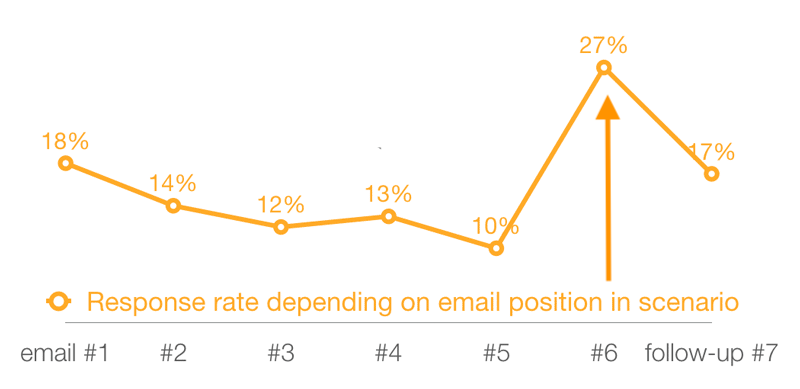
Vasconcelos also found that at least 5-6 follow-up emails after no response was needed to close the sale: “We normally send 5 to 6 follow-up emails in our email campaigns,” said Vasconcelos. “Obviously, we’ve had some prospects grumbling about how bothersome we are, but we can’t suit all tastes, and it’s proven that it works!
It may feel hopeless to spend time writing follow-up emails to an unresponsive prospect. But remember, it can take up to six attempts to receive a response, and unless your prospect explicitly tells you they aren’t interested, there’s still a possibility the sale might happen.
3. Offer something valuable with each follow-up email.
Your prospect isn’t going to respond to your follow-up email if there’s nothing in it for them. Expert sales consultant Ian Brodie’s advice from ensuring your prospects respond is to “make each interaction value-added.”
While this may seem like a daunting task, offering something valuable in every single follow-up email does not have to be a heavy lift. It can be as simple as offering your prospect a free demo of your product; sending them a useful resource, such as a blog post; or offering to talk through their pain points with them by jumping on a 15-minute call.
Always look for ways to provide value in your follow-up emails. If prospects see that you have their best interests in mind, they’ll be likely to respond.
4. Be patient with your prospects.
The quickest way to irritate a prospect is to send them rapid-fire emails multiple times a day. Give prospects time to read each email before sending another.
Maria Siewierska, lead-generation writer at Woodpecker.co, strongly advises against being pushy with prospects.
Your prospects are human beings with their own problems and deadlines to take care of. They don’t sit around and wait for anybody to email them. They don’t expect your message. They don’t even know you. At times, it takes more than one day to reply to emails that are not “top priority.” Be patient and give them some time to react before you send them another follow-up.
Be patient with your prospects. Give them the same amount of time you would need to discover, read, and respond to an unexpected email.
5. Keep your emails short and sweet.
The more information you ask your prospects to digest in a single follow-up email, the less likely they’ll read it. A survey by Boomerang found that emails with the highest response rates were brief, with 50 to 125 words.
Avoid overloading your prospect with information. Instead of covering a large number of ideas, just use your email to explain the next steps for your prospect. For example, your email might focus on offering a product demo to the potential customer.
After all, your goal is to initiate a two-way conversation with your prospect. Nothing more, nothing less. As Jeffrey Gitomer once said, “It’s just a tool to get face to face or phone to phone.”
Just remember to keep it simple. The less you ask of your prospect in a follow-up email, the more likely they’ll be to respond.
6. Personalize subject lines.
The subject line of your follow-up email is your prospect’s first impression of what’s to come from your email. It impacts whether your prospect opens the message, trashes it, or, worse, flags it as spam.
Encourage prospects to open your messages by personalizing subject lines. According to data presented by Yes Lifecycle Marketing, personalization can “increase open rates by 50% and lead to 58% higher click-to-open rates.”
There are several different ways a sales rep can personalize a follow-up email subject line, such as including your prospect’s name or referencing something specific they once said to you in a previous conversation. Here are a few ideas from Adam Chalker of Black Briefcase:
- “10x [prospect’s company]’s traction in 10 minutes.”
- “I found you through [referral name].”
- “We have [insert fact] in common.”
- “So nice to meet you, [Prospect]!“
Additionally, if you use a CRM system like Sell to send your follow-up emails, you can easily monitor the effectiveness of your subject lines by seeing whether or not your emails were opened/“viewed.”

As you can see in the photo above, Sell’s dashboard allows you to see whether or not your prospects have actually opened your follow-up email. If you’re seeing that a lot of emails are going unread, you may want to adjust your subject lines.
You can’t expect a prospect to respond to your message if it feels like just another generic email blast. Avoid this pitfall by showing prospects that you value them individually by using personalized subject lines.
Close more deals with follow-up emails
It’s not always easy to connect with your prospects. They might miss your emails, discard them, or simply ignore them altogether. The key to reengaging with these prospects (and closing the deal) is knowing how to write and deliver a personalized and well-timed email that provides value to your prospect.
Use the expert tips in this guide to ensure that your follow-up emails help you hit your sales goals faster!
Digital & Social Articles on Business 2 Community
(49)
